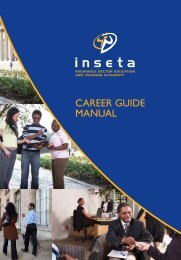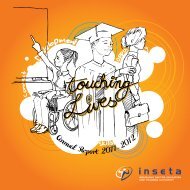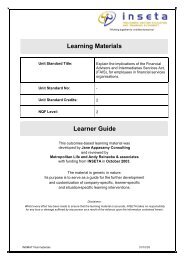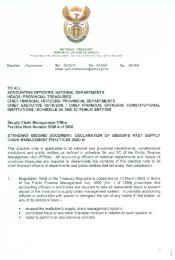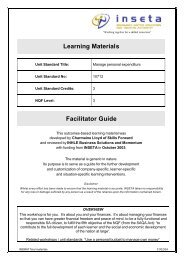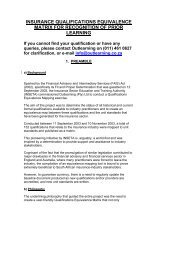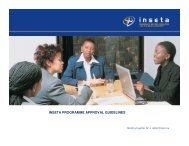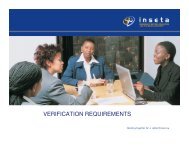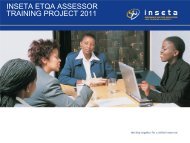SSP Brochure:Layout 1 - INSETA
SSP Brochure:Layout 1 - INSETA
SSP Brochure:Layout 1 - INSETA
Create successful ePaper yourself
Turn your PDF publications into a flip-book with our unique Google optimized e-Paper software.
Table 3.13 People to be trained in 2006/2007 according to occupational category 59Occupational Group Total employed Earmarked for Training % to be trainedLegislators, senior officials and managers 3 750 2 004 53Middle to Junior Management 4 161 3 350 81Professionals 6 649 3 902 59Technicians and associate professionals 24 732 16 640 67Clerks (Clerical & Administrative workers) 23 650 16 248 69Service and sales workers 21 219 15 119 71Skilled/Craft & Related Trade Workers 1 251 317 25Labourer / Elementary occupations 1 335 554 41Total 86 747 58 134 67* Employment figures refer only to the people employed in the organisations that submitted WSPs in respect of 2006/2007 to the <strong>INSETA</strong>. For this reason, the total figuresdiffer from the total employment estimates cited in Chapters 1 and 2.Source:WSPs 2006/2007.3.5 Abet trainingThere is only a small number of workers in this sector who have qualifications below NQF level 1 and who would benefit from adult basiceducation and training (ABET). In 2004/2005 employers who submitted ATRs trained 285 people (0.4% of their total workforce) onABET programmes – most of them African men and women who worked in clerical or administrative positions (Table 3-14).Table 3.14 People trained on ABET programmes in 2004/2005Occupational Group Male Female TotalClerical/Administrative Workers 72 128 200Service and Sales Workers 12 11 23Skilled/Craft & Related Trade Workers 4 2 6Labourers/Elementary Workers 24 32 56Total 112 173 285Source: ATRs 2004/2005In the 2006/2007 year <strong>INSETA</strong> supported the training of 547 learners on ABET programmes through its bursary voucher sytem.3.6 Special Inseta initiativesThe <strong>INSETA</strong> initiated three programmes to support and assist the insurance industry to develop its management cadre:• ELDP – The <strong>INSETA</strong>/GSB Executive Leadership Development Programme (ELDP) has been created to provide the South AfricanInsurance industry with skilled and confident leaders. In line with the SA Financial Sector Charter, the ELDP aims to fast track senior andemerging executives, especially previously disadvantaged individuals, for leadership positions in the insurance industry. From 2003 to2005 25 people have attended ELDP each year.• Vulindlela – This is a Leadership and Management Programme that started in 2006 to replace the ELDP, run by <strong>INSETA</strong>/GSB and isparticularly aimed at developing leadership and management skills in Black leaders in the Insurance Sector.• LAP - The Leadership Advancement Programme (LAP) is intended to fast track the development of middle and emerging managers inthe insurance industry. Attendance of this programme was as follows:• 2003 – 50,• 2004 - 52 and• 2005 – 39.• WIN – The Women in Insurance (WIN) Programme is a Management Development Programme, aimed at women in the financialservices sector and comprises of academic, behavioural, personal development and coaching and mentoring components which willequip learners to function in leadership positions within their organisations. The programme consists of academic as well as insurance –specific input. In 2004 30 women attended the programme and in 2005 27 attended.In 2007 all three programmes were discontinued and the <strong>INSETA</strong> introduced a bursary programme to provide financial support toemployers to send learners on training programmes of their own choice. The number of learners who benefited from this programme in2006/2007 can be seen in Table 3.15.59 At the time of writing this <strong>SSP</strong> update the ATR figures for the 2005/2006 financial year were not yet available.<strong>INSETA</strong> Sector Skills Plan - page 31




